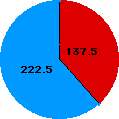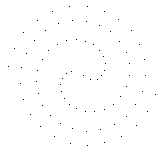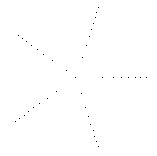The ![]() icon means there is a Things to do investigation at
the end of the section.
icon means there is a Things to do investigation at
the end of the section.
Why does nature like using Phi in so many plants?The answer lies in packings - the best arrangement of objects to minimise wasted space.
 |
...square objects would pack most closely in a square array,
whereas round objects pack better in a hexagonal arrangement.... |
 |
What nature seems to use is the same pattern to place seeds on a seedhead as it used to arrange petals around the edge of a flower AND to place leaves round a stem. What is more, ALL of these maintain their efficiency as the plant continues to grow and that's a lot to ask of a single process!
So just how do plants grow to maintain this optimality of design?
Also, these cells grow in a spiral fashion, as if the stem turns by an angle and then a new cell appears, turning again and then another new cell is formed and so on.
These cells may then become a new branch, or perhaps on a flower become petals and stamens.
The amazing thing is that a single fixed angle can produce the optimal design no matter how big the plant grows. So, once an angle is fixed for a leaf, say, that leaf will least obscure the leaves below and be least obscured by any future leaves above it. Similarly, once a seed is positioned on a seedhead, the seed continues out in a straight line pushed out by other new seeds, but retaining the original angle on the seedhead. No matter how large the seedhead, the seeds will always be packed uniformly on the seedhead.
And all this can be done with a single fixed angle of rotation between new
cells?
Yes! This was suspected by people as early as the last century.
The principle that a single angle produces uniform packings no matter how much
growth appears after it was only proved mathematically in 1993 by Douady and
Couder, two french mathematicians.
You will have already guessed what the fixed angle of turn is - it is Phi cells per turn or phi turns per new cell.
 However, we tend to "see" the smaller angle which is
(1-0·618034)x360 = 0·381966x360 = 137·50776..°. When we look at properties of
Phi and phi on a later page, we shall see that
However, we tend to "see" the smaller angle which is
(1-0·618034)x360 = 0·381966x360 = 137·50776..°. When we look at properties of
Phi and phi on a later page, we shall see that
Let's now try and show just why phi is the best angle to use in the next few sections of this page.
The links in this section are to Quicktime animations. They are worth viewing as they show the dynamics of what might happen if seeds were not placed with a phi-angle between them.
Why not 0·6 of a turn per seed or 0·5 or 0·48 or 1·6 or some other number?First we can agree that turning 0·6 of a turn is exactly the same as turning 1·6 turns or 2·6 turns or even 12·6 turns because the position of the point looks the same. So we can ignore the whole number part of a turn and only examine the fractional part.
Also, since a 0·6 of a turn in one direction is the same as 0·4 of a turn in the other, we could limit our investigation to turns which are less than 0·5 too. However sometimes it will be easier to talk of fractions of a turn which are bigger than 0·5 or even that are bigger than 1, but the only important part of the number is the fractional part.
So, in terms of seeds - which develop into fruit - what is a fruit-ful numbers? Which has the best properties as a turning angle for our meristem? It turns out that numbers which are simple fractions are not good choices, as we see in the next section.
A circular seedhead is more compact and would have better mechanical strength and so be better able to withstand wind and heavy rain.
 Here is 0·48 of a turn between seeds.
Here is 0·48 of a turn between seeds. 
What do you think will happen with 0·6 of a turn between
successive seeds?
Did you expect it to be so different?
Notice how the
seeds are not equally spaced, but fairly soon settle down to 5 "arms". Why?
Because 0·6=3/5 so every 3 turns will have produced exactly 5
seeds and the sixth seed will be at the same angle as the first, the seventh in
the same (angular) position as the second and so on. The seeds appearing at
every third arm, in turn, round and round the 5 arms. So we count 3-of-the-5
(3/5) to find the next "arm" where a seed will appear.
So what seems to be important is just the fractional part of our seeds-per-turn value and we can ignore the whole number part. There is another value that will give the same animation too. What is it? Well, if we went 0·6 of a turn in the other direction, it is equivalent to going 1-0·6=0·4 of a turn between seeds. So also would be 1·4, 1·4, 3·4 and so on.If we try 1·6 or 2·6 or 3·6 can you see that we will get the same animation since the extra whole turns do not affect where the seeds are placed?
Here's what happens if we have a value closer to phi(0·6180339..), namely 0·61. You'll notice that it is better, but that there are still large gaps between the seeds nearest the centre, so the space is not best used. This is also equivalent to using 1·61, 2·61, etc. and also to 1-0·61=0·39 and therefore to 1·39 and 2·39 and so on.
In fact, any number which can be written as an exact ratio (a rational
number) would not be good as a turn-per-seed angle.
If we use p/q
as our angle-turn-between-successive-turns, then we will end up with q straight
arms, the seeds being placed every p-th arm. [This explains why 0·6=3/5 has 5
arms and the seeds appear at every third arm, going round and round.]
So what is a "good" value? One that is NOT an exact ratio since very
large seed heads will eventually end up with seeds in straight lines.
Numbers
which cannot be expressed exactly as a ratio are called irrational
numbers (ir-ratio-nal) and this description applies to such values as ![]() 2,
Phi, phi, e,
pi
and any multiple of them too.
2,
Phi, phi, e,
pi
and any multiple of them too.
You'll notice that the e(2·71828...) animation has 7 arms since its
turns-per-seed is (two whole turns plus) 0·71828... of a turn, which is a bit
more than 5/7(=0·71428..).
A similar thing happens with pi(3·14159..) since
the fraction of a turn left over after 3 whole turns is 0·14159 and is close to
1/7=0·142857.. . It is a little less, so the "arms" bend in the
opposite direction to that of e's (which were a bit more than
5/7).
These rational numbers are called rational approximations to the
real number value.
If we take more and more seeds, the spirals alter and we
get better and better approximations to the irrational value.
What is "the best" irrational number?
One that never settles down
to a rational approximation for very long. The mathematical theory is called
CONTINUED FRACTIONS.
The simplest such number is that which is
expressed as P=1+1/(1+1/(1+1/(...) or, its reciprocal
p=1/(1+1/(1+1/(...))).
P is just 1+1/P, or P2=P+1.
p is just
1/(1+p) so p2+p=1.
We will see later that these are just
definitions of Phi (P) and phi (p) (and their negatives)!
The exact value of
Phi is (![]() 5 +
1)/2
5 +
1)/2
and of phi is (![]() 5 – 1)/2.
5 – 1)/2.
Both are irrational numbers whose rational
approximations are ...
phi: 1/1, 1/2, 2/3, 3/5, 5/8, 8/13, 13/21, ... Phi: 1/1, 2/1, 3/2, 5/3, 8/5, 13/8, 21/13, ...
which is why you see the Fibonacci spirals in the seed heads!
Here is another quicktime movie which shows various turns-per-seed values near phi (0·61803) showing that there are always gaps towards the outer edge of the "seedhead" and that phi gives the best value for all sizes of flowerhead.
|
The technical term for the study of the arrangements of leaves and of seedheads in plants is phyllotaxis.
![]() An
important technical paper about phi and its optimal properties for plant growth
can be found in Phyllotaxis as a self-organised growth process by
Stephane Douady and Yves Couder, pages 341 to 352 in Growth Patterns in
Physical Sciences and Biology, (editor J M Garcia-Ruiz et al), Plenum
press, 1993.
An
important technical paper about phi and its optimal properties for plant growth
can be found in Phyllotaxis as a self-organised growth process by
Stephane Douady and Yves Couder, pages 341 to 352 in Growth Patterns in
Physical Sciences and Biology, (editor J M Garcia-Ruiz et al), Plenum
press, 1993. ![]() A history of the study of phyllotaxis by I Adler, D Barabe, R V
Jean in Annals of Botany, 1997, Vol.80, No.3, pp.231-244.
A history of the study of phyllotaxis by I Adler, D Barabe, R V
Jean in Annals of Botany, 1997, Vol.80, No.3, pp.231-244. ![]() A better way
to construct the Sunflower head in Mathematical Biosciences volume
44, (1979) pages 145 - 174.
A better way
to construct the Sunflower head in Mathematical Biosciences volume
44, (1979) pages 145 - 174.
![]() A H Church
On the relation of Phyllotaxis to Mechanical Laws, published by
Williams and Norgat, London 1904.
A H Church
On the relation of Phyllotaxis to Mechanical Laws, published by
Williams and Norgat, London 1904.![]() E E Leppik, Phyllotaxis,
anthotaxis and semataxis Acta Biotheoretica Vol 14, 1961, pages
1-28.
E E Leppik, Phyllotaxis,
anthotaxis and semataxis Acta Biotheoretica Vol 14, 1961, pages
1-28.![]() F J
Richards Phyllotaxis: Its Quantitative Expression and Relation to growth
in the Apex Phil. Trans. Series B Vol 235, 1951, pages
509-564.
F J
Richards Phyllotaxis: Its Quantitative Expression and Relation to growth
in the Apex Phil. Trans. Series B Vol 235, 1951, pages
509-564.![]() D'Arcy W Thompson On
Growth and Form Dover Press 1992.
D'Arcy W Thompson On
Growth and Form Dover Press 1992.
This is the complete edition!
(Click on the title-link for more information and to order it now.)
There is
also an
abridged version from Cambridge University press (more information and order
it on line via the title-link.)![]() T A Davis, Fibonacci Numbers for
Palm Foliar Spirals Acta Botanica Neelandica, Vol 19, 1970,
pages 236-243.
T A Davis, Fibonacci Numbers for
Palm Foliar Spirals Acta Botanica Neelandica, Vol 19, 1970,
pages 236-243.![]() T A Davis Why Fibonacci Sequence for Palm Leaf
Spirals?, Fibonacci Quarterly, Vol 9, 1971, pages
237-244.
T A Davis Why Fibonacci Sequence for Palm Leaf
Spirals?, Fibonacci Quarterly, Vol 9, 1971, pages
237-244.![]() The
Algorithmic Beauty of Plants by P Prusinkiewicz, and A Lindenmayer,
published by Springer-Verlag (Second printing 1996) is an astounding book of
wonderful images and patterns in plant shapes as well as algorithms for
modelling and simulation by computer. (For more information and how to order it
online use the title-link).
The
Algorithmic Beauty of Plants by P Prusinkiewicz, and A Lindenmayer,
published by Springer-Verlag (Second printing 1996) is an astounding book of
wonderful images and patterns in plant shapes as well as algorithms for
modelling and simulation by computer. (For more information and how to order it
online use the title-link).
Related to this book is:![]() The
Algorithmic Beauty of Sea Shells (Virtual Laboratory) in hardback by Hans
Meinhardt, Przemyslaw Prusinkiewicz, Deborah R. Fowler (more information and
order it online via this title-link).
The
Algorithmic Beauty of Sea Shells (Virtual Laboratory) in hardback by Hans
Meinhardt, Przemyslaw Prusinkiewicz, Deborah R. Fowler (more information and
order it online via this title-link).![]() The
Curves of Life: Being an Account of Spiral Formations and Their Application to
Growth in Nature, to Science, and to Art Sir Theodore A Cook, Dover books,
1979, ISBN 0 486 23701 X.
The
Curves of Life: Being an Account of Spiral Formations and Their Application to
Growth in Nature, to Science, and to Art Sir Theodore A Cook, Dover books,
1979, ISBN 0 486 23701 X.
A Dover reprint of a classic 1914 book. (More
information and you can order it online via the title-link.)![]() Also see H S M Coxeter's Introduction
to Geometry, published by Wiley, in its Wiley Classics Library
series, 1989, ISBN 0471504580, especially chapter 11 on Phyllotaxis. (More
information and order it online via the title-link.)
Also see H S M Coxeter's Introduction
to Geometry, published by Wiley, in its Wiley Classics Library
series, 1989, ISBN 0471504580, especially chapter 11 on Phyllotaxis. (More
information and order it online via the title-link.)
| There are no earlier topics: this is the first. |
WHERE TO NOW?? This is the last page on this topic. | The next Topic is... |
© 1996-2004 Dr Ron Knott